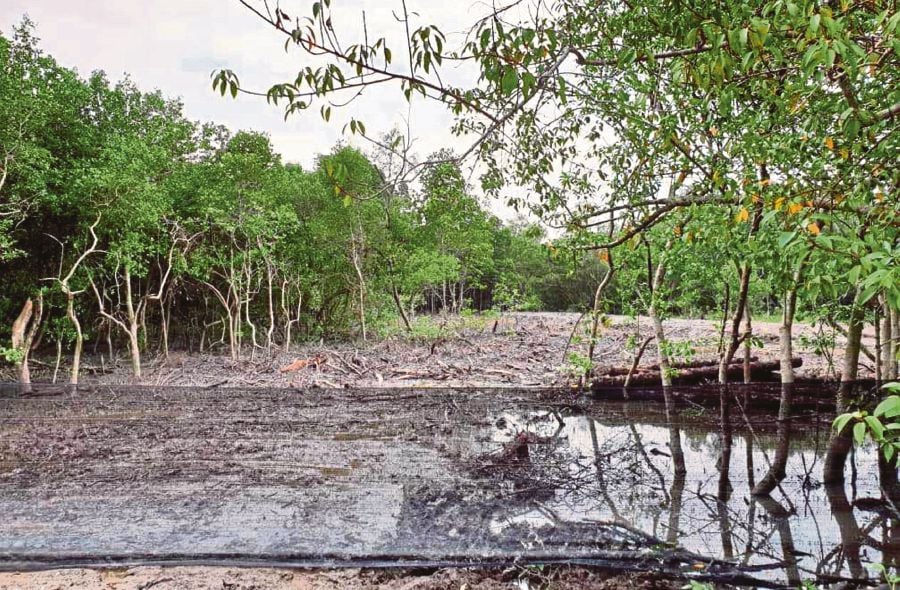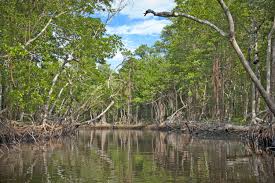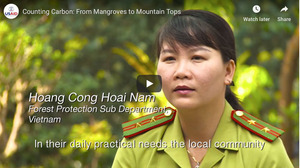5 reasons to protect mangrove forests for the future 
GLOBAL – To the uninitiated, mangroves might appear to be merely coastal cousins of inland forests, but these rich ecosystems support the planet and people in unique ways, from providing breeding grounds for fish to carbon storage, to protection against flooding. Yet despite their importance, mangrove forests are under threat. Over a third have already disappeared, and in regions such as the Americas they are being cleared at a faster rate than tropical rainforests. Much of that clearance is to reclaim land for agriculture, industrial development and infrastructure projects. In addition to climate change and pollution, there are also local threats. These include overharvesting of wood for fuel and construction, dams and irrigation that reduce the flow of water reaching the forests, and overfishing causing disruption to food chains and fish communities.
READ MORE AFRICA
Chicken Farm Community Joins Fight to Protect Mangrove

LIBERIA – A group of community dwellers in Chicken Farm community, Jacob’s Town, outside Monrovia, has joined the fight to protect 35 percent of Liberia’s mangroves along the Mesurado river through sustainable use of the forest. The group of citizens, named “Chicken Farm Neighborhood Dwellers,” has called on the government and its international partners to do more to prevent flooding, sand mining, and the destruction of wildlife. The group also wants government to put an end to the massive destruction of mangroves along the Mesurado river. In a letter addressed to Nathaniel Blama, Executive Director of the Environmental Protection Agency (EPA), dated January 30, 2019, a copy of which is in the possession of this writer, the residents complained that some unknown individuals are aggressively destroying mangrove trees for the purpose of selling swampland and fetching wood. The community has repeatedly suffered from property damage as a result of flooding when the Mesurado river overflows. READ MORE
Lamu residents decry mangrove logging ban

KENYA – Cutting and trading of mangrove trees are now banned in Kenya, but Kenyans warn their houses and mosques may collapse. A ban on the cutting or trading of mangrove trees in Kenya has angered many across the island of Lamu. The government says the decision will help the environment, but residents argue they have no other material to construct and repair their buildings. Residents of Lamu are warning that this ban could lead to their homes and mosques collapsing. A section of Lamu's 300-year-old Jamia Mosque faces imminent collapse. The faithful are now forced to pray on just one side of the mosque. READ MORE
Marine conservation gives life to the ocean, boosts livelihoods

KENYA – Amina Ahmed Mohammed has watched men prepare fishing gear and take to the waters in Lamu to fend for their families since she was a child. That was until the tide changed. Today, as men sail away to the deep oceans to catch fish, Amina leads her own band of women into the shallow edges of the ocean to catch octopus. And the way nature does it is so befitting to their roles that she has no qualms going about it. While the men take to the waters at the crack of dawn, Amina and her team have to wait for the tide to recede before they begin the long trudge to locate corals where octopus inhabit. Pate Women Group chairlady Arafa Aboud says 80 women are involved in replanting of mangroves. “We educate our children from mangrove products and we must ensure the forests thrive to benefit future generations,” she says. READ MORE
ASIA
Denmark funds mangrove reforestation in Rakhine

MYANMAR – A Five-year plan to replant mangrove forests is being undertaken on the Rakhine State coast with the help of the Danish government, a Forest Department official said. U Toe Aung of the department’s Mangrove Conservation Unit said the five-year project will focus on degraded mangrove forests in Myebon and Rambre townships. It started in June 2018 and will end in 2023. According to the department, mangroves cover 76 percent of Rakhine’s coast, 29pc of the Ayeyarwady delta, and 98pc of Tanintharyi Region in 2015. But conservation experts said many mangroves are being destroyed to breed fish and prawns, and farmland. “Mangrove forests in Sittwe township are now prawn farms. We will replant mangroves in prawn farms that are no longer used,” U Toe Aung said. One problem is that mangroves, forest reserves and protected areas have not been clearly defined, and group-owned forests have not been established in Sittwe, he added. READ MORE
Farmers profit from breeding crabs amid mangroves

VIETNAM – In early 2017, the association started the model in the district’s Nam Thai Commune after many of the households suffered losses from raising black tiger shrimp, fish and other kinds of crabs in mangrove forests which they were assigned to protect and harvest products. Le Minh Khang, who was allocated 8ha of protective forestry land in Nam Thai in 1992, said after receiving the land, he used 70 per cent of the area to grow mangrove forests and the rest to breed black tiger shrimp, crabs and fish. In the first years, mangrove trees were small and water resources were clean, yielding profits from black tiger shrimp, crabs and fish. However, mangrove trees are now bigger and their fallen leaves pollute water resources, affecting the breeding of the aquatic species in the mangrove forest, according to Khang. READ MORE
Mangrove ecosystem's importance not understood

MALAYSIA – Mangroves can be found in 118 countries in the world, representing one per cent of the tropical forest worldwide, and less than 0.4 per cent of the world forests. Mangrove swamps provide a very important ecosystem to both human life and the diversity of life that inhabits it. Unfortunately, not many are aware of the importance of the mangrove ecosystem, causing them to be neglected, thus leading to the threat of its extinction. This is evident throughout Malaysia today in which mangroves are becoming increasingly threatened by various unhealthy human activities, such as reclamation of land for aquaculture, agriculture, industry or housing, coastal resort development, ports, roads, airports and oil exploration; widespread logging; and pollution. It was recently reported that the sole surviving mangrove forest on government land located in the middle of Pekan Baru Batu Maung and adjacent to the Bayan Lepas Industrial Park was being threatened by irresponsible dumping of construction and industrial wastes. READ MORE
Malaysian Federal Government supports indigenous peoples’ rights

MALAYSIA – In what seems to mark a significant shift in government policy, the Malaysian Government has sued the State Government of Kelantan for its alleged failure to protect Orang Asli rights to their lands in violation of the Constitution. The Orang Asli (‘original peoples’) are the indigenous peoples of Peninsular Malaysia. Orang Asli spokespersons have been reported to welcome the decision but have called for legal reforms to secure their customary rights through statutory law. During the British colonial period, the so called ‘aboriginal peoples’ of the Malay Peninsula were tolerated but their rights were never formally recognised. The British sought to encourage the Orang Asli, who lived by hunting and gathering and small-scale shifting cultivation mainly in the forested uplands, to settle down. Small reserves set up for their settlements were gazetted but legally remained Crown lands. READ MORE
AMERICA
Appeals court clears way for landowner to drill exploratory oil well in Everglades

USA – Overturning a decision by the Florida Department of Environmental Protection, an appeals court Tuesday ordered the state to issue a permit to a major Broward County landowner who wants to drill an exploratory oil well in the Everglades. A three-judge panel of the 1st District Court of Appeal ruled the department improperly rejected a recommended order by an administrative law judge, who said in 2017 a permit should be approved for Kanter Real Estate LLC. The 14-page ruling Tuesday said, in part, that Department of Environmental Protection Secretary Noah Valenstein improperly rejected “factual findings” by Administrative Law Judge E. Gary Early. Those findings included that the site targeted for exploratory drilling was environmentally degraded and was isolated from surface water and groundwater. READ MORE
Submissions requested to Wildlife Conservation Film Festival

USA – Join us for the 9 year anniversary of the WCFF from October 17-27, 2019 in New York, NY. Over 100 documentary films representing many nations will be screened. In attendance will be international filmmakers and scientists. Interested in submitting a film for the 2019 Festival? Contact: info@wcff.org to request a film entry application. Take part in the only film festival on the globe dedicated to wildlife conservation. Our mission is to inform, engage and inspire audiences about the need for and importance of the protection of global biodiversity. READ MORE
OCEANA
FIGHTING GLOBAL WARMING WITH BLUE CARBON

AUSTRALIA – Breathe deeply. All that lovely oxygen you’re getting right now was recycled somewhere by plants (and plankton). But it’s not just the land-based plants responsible for restoring Earth’s oxygen supply—marine plants also play an important role. Mangroves, seagrasses and inhabitants of salt marshes are just some of the plants responsible for creating something called blue carbon. But this important part of underwater ecology looks more brown and green than a pretty aqua hue. It works like this: marine plants capture carbon dioxide during photosynthesis, just like their terrestrial siblings. The plants transform the carbon into carbohydrates, which are then used by the plant to grow stems, leaves and flowers. When the plant dies, the carbon locked in its tissues is trapped, stored underground. Mat Vanderklift, a marine ecologist at CSIRO, says because this trapped carbon is waterlogged, very little oxygen gets to it and it cannot decompose. The carbon can remain trapped much more efficiently than land-based carbon traps, like trees. READ MORE
LAST WORD
Hello Alfredo & team,
On behalf of Save Maldives team and other activists and movements working towards
environmental protection and conservation in the Maldives, we would like to extend our
gratitude for your continued support to our efforts and work.
Since you have mentioned the effectiveness of letter writing in previous emails, I would like to know that it had a huge impact.
For example, our friend working as the National Coordinator for Mangroves for the Future (MFF) the Maldives reported that the letter from MAP with concern for Kulhudhuffushi mangroves was discussed in a meeting of the National Coordination Body. It was widely covered by the media and garnered attention on social media and led to subsequent discussions on these platforms as well. READ MORE
Back to Top




























